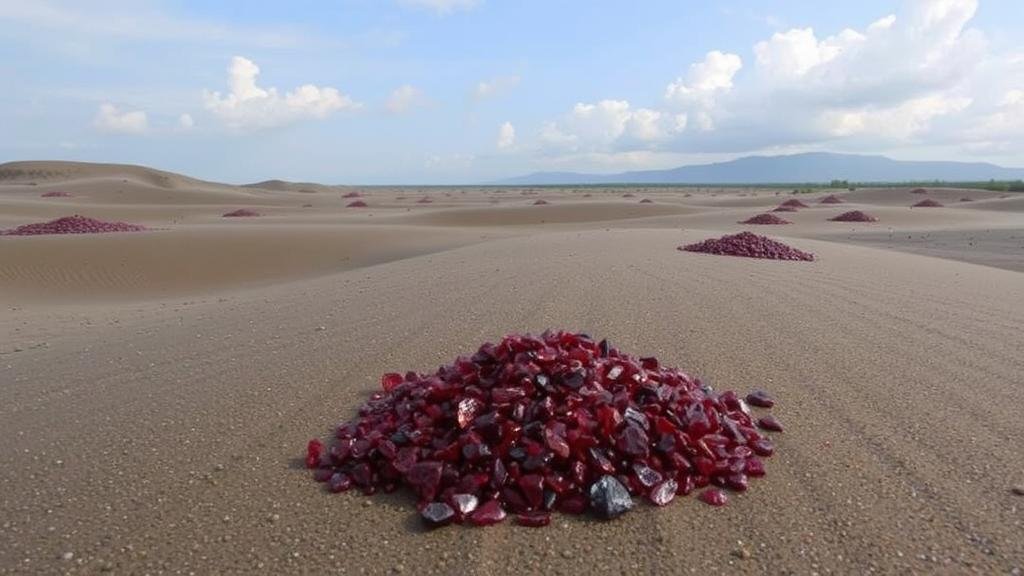Searching for garnet sands in Sri Lanka’s coastal plains, long a source of the world’s most exquisite stones.
Exploring Sri Lanka’s Garnet Sands: A Treasure for Rockhounds and Mineral Collectors
Sri Lanka, an island nation in the Indian Ocean, is renowned for its stunning beauty and natural resources, particularly its precious gemstones. Among these, garnet holds a prominent place–not just in the jewelry market but also as a coveted find for rockhounds and mineral collectors. The coastal plains of Sri Lanka are rich with garnet sands, making them a prime location for those seeking to unearth these exquisite stones.
The Geography and Geology of Garnet Sands
The coastal plains of Sri Lanka, particularly in regions like the southern coast around Galle and the eastern shores near Trincomalee, feature unique geological formations that contribute to the presence of garnet sands. Nilgala gem field, for example, showcases an intricate interplay of sedimentary processes situated on high-grade metamorphic rocks. Over millions of years, erosion has washed down these minerals from the neighboring hills into the coastal sedimentation zones.
Most garnet found in Sri Lanka belongs to the almandine variety, recognized for its deep red to violet hues. According to the Gemological Institute of America, garnet sands can contain up to 30% garnet concentrations in certain areas, making them exceptionally rich for collectors.
Types of Garnet Found in Sri Lanka
Garnets are a group of silicate minerals that share similar physical properties but come in diverse colors and compositions. types of garnet collectors are likely to encounter in Sri Lanka include:
- Almandine: Typically red to violet, it is the most common variety found in Sri Lanka.
- Pyralspite: This includes a mix of pyrope and spessartine, offering a vibrant range of colors from deep red to yellowish hues.
- Grossular: Often found in shades of green and yellow, grossular garnets can provide a colorful addition to any collectors portfolio.
For rockhounds and mineral collectors looking to delve into the world of garnet sands in Sri Lanka, it is essential to approach the task with knowledge and preparation. Here are some practical tips:
- Research Local Laws: Before embarking on a collecting trip, check the local regulations regarding gem collection. Certain areas may have restrictions, and permits may be required.
- Invest in Proper Tools: A good set of tools, including a sieve, shovel, and a hand lens, can greatly enhance the collecting experience. Use a sieve to separate garnet from sand particles effectively.
- Seek Local Guidance: Engaging with local gem merchants or guides can provide valuable insights into productive collecting spots and techniques.
- Practice Sustainable Collecting: Ensure that your collecting methods are environmentally friendly. Avoid damaging the habitat and consider participating in cleanup activities when possible.
Real-World Applications and Market Insights
The garnet collected from Sri Lankan sands holds significant commercial value. In 2022 alone, the global garnet market was valued at approximately $918 million, with projections to grow as the demand for sustainable and ethically sourced gemstones rises. garnet’s versatility extends beyond jewelry; it is also utilized in industrial applications such as abrasive materials, making it an attractive investment for collectors.
Plus, garnet’s historical significance stretches back to ancient civilizations, where it was believed to have healing properties and protective qualities. This rich lore adds another layer of appeal for enthusiasts and collectors.
Conclusion: Treasure Awaits
For rockhounds and mineral collectors, Sri Lankas coastal plains offer a unique opportunity to discover and collect some of the worlds most exquisite garnets. With its varied geological landscape, a diverse range of garnet types, and the potential for sustainable collecting, Sri Lanka is a true gem in the world of mineralogy.
As you plan your adventure, remember the importance of research, preparation, and respect for the environment. Happy collecting!



